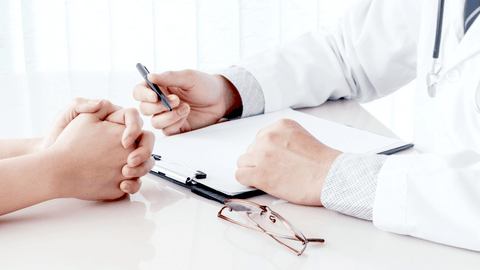Treatment for Endometriosis
Research shows that endometriosis contributes to approximately 25% to 50% of all female infertility cases globally, which makes endometriosis treatment a crucial topic of discussion. This article provides a detailed overview of treatment of endometriosis. Moreover, it discusses the prevalence of endometriosis, its symptoms, as well as its causes.

What Is Endometriosis?
Endometriosis is a condition in which tissue similar to the lining of the inner uterine wall or endometrium grows externally. Thus, the endometrium develops in the wrong locations where it is unwanted, such as:
- Vagina
- Outside and at the back of the uterus
- Fallopian tubes
- Diaphragm
- Peritoneum
- Ovaries
- Rectum
- Intestines
- Bladder
- Pelvic cavity
The tissue gets thicker, disintegrates and bleeds alongside each menstrual cycle. However, unlike the usual periods, the blood doesn’t find a way to exit the body and gets trapped.
This condition causes chronic inflammation that can lead to scarring in the pelvis. As a result, you may experience pain while urinating, having sex, or during bowel movements. Also, you may have difficulty trying to get pregnant.
Endometriosis is most prevalent among women of reproductive age and affects about 190 million women globally. This condition can significantly affect your life and may sometimes cause depression. However, there are therapies and treatments that can assist in relieving the impact.
Different types of endometriosis exist, characterised by the location of the tissue and how deep it penetrates. They include:
Superficial Peritoneal Endometriosis
Superficial peritoneal endometriosis occurs when the endometrial cells get implanted in the peritoneum, also known as the lining of the pelvic cavity.
Endometriomas
Endometriomas are fluid-filled dark cysts that form on the ovaries. They are also known as chocolate cysts because of their colour. The cysts often cause pain and can lead to infertility.
Deeply Infiltrating Endometriosis (DIE)
The endometrial-like tissue invades the pelvic organs or other organs outside the pelvic cavity, such as the bladder, bowel, rectum, or vagina. DIE can cause severe pain, scarring, and adhesions (bands of fibrous tissue that stick organs together).
Abdominal Wall Endometriosis
Abdominal wall endometriosis is when the endometrial tissue grows in the abdomen, usually near a surgical scar, such as from a caesarean section or hysterectomy.
Endometriosis Treatment
While no known cure for endometriosis exists, treatment focuses on relieving the symptoms. The available options for treating endometriosis comprise hormone therapy, analgesics, and surgical procedures to eliminate endometriosis tissue.
The mode of treatment your doctor uses depends on several factors, such as the severity of symptoms, the extent of the condition, and your preferences and desires for fertility. Timely diagnosis and commencement of treatment are vital in managing the symptoms and controlling the impact of the disease. In further detail, let’s look at some of the most common alternative ways to treat endometriosis.
Hormone Treatment
Hormonal treatments aim to control the hormonal fluctuations that trigger the growth and shedding of endometrial tissue outside the uterus. These treatments include:
- Birth control pills: Oral contraceptive drugs can help regulate the menstrual cycle and limit the development of endometrial tissue.
- Progestin therapy: Progestin-only contraceptives, such as hormonal intrauterine devices (IUDs), implants, or injections, can help suppress the growth of endometriosis.
- Aromatase inhibitors: These are medications that block the enzyme responsible for the production of oestrogen. By inhibiting oestrogen production, these drugs reduce the growth of endometriosis and associated symptoms.
- Gonadotropin hormone-releasing hormone (GnRH) agonists and antagonists: These medications induce a temporary menopause-like state, reducing oestrogen production and slowing down the growth of endometrial tissue. However, since this therapy causes menopause, it is usually used for a limited duration due to side effects like decreased bone density.
- Danazol: This medication suppresses oestrogen and progesterone production, effectively reducing endometriosis symptoms. However, it may cause significant side effects and is usually considered a last resort option.
Conservative Surgery
In cases where medication does not effectively manage symptoms or when there are structural abnormalities, your physician may recommend surgery. Conservative surgery removes endometriosis lesions without interfering with your body organs.
The options include:
- Laparoscopy: This minimally invasive procedure removes visible endometrial implants and scar tissue.
- Laparotomy: In more severe cases, a larger incision may be necessary to remove deeply infiltrated endometrial tissue or cysts.
Hysterectomy With Removal of the Ovaries
This option involves removing the uterus and the ovaries. Your doctor may advise you to consider this when other treatments have failed, and you do not desire future fertility. Also, removing the ovaries reduces your risk of ovarian cancer.
However, if you are premenopausal, you will no longer have oestrogen protection, which may increase your risk of osteoporosis and heart disease. Therefore, your fertility doctor should help you evaluate your options and potential benefits and risks to make a suitable choice.
Pain Medication
Pain relievers like naproxen, sodium, or ibuprofen can be used to treat and alleviate mild to moderate pain associated with endometriosis. In more severe cases, stronger prescription pain medications may be prescribed.
What Are Some Symptoms of Endometriosis?
The signs of endometriosis may vary from person to person. Some people do not show any symptoms. Pelvic pain is the most noticeable, especially during sex, menstruation, defecation, or urination.
Other common symptoms may be:
- Fatigue
- Cramping or abdominal fullness
- Heavy menstrual bleeding
- Nausea or constipation
- Irregular menstrual periods
- Difficulty getting pregnant
- Presence of blood in poo or pee during menstruation
- Spotting between periods
Schedule a consultation with your reproductive health provider If you feel constant pain in your pelvis. Recording your symptoms before visiting the doctor can be helpful because some other conditions share similar signs.
What Is the Cause of Endometriosis?
Studies are still ongoing to establish the exact cause of endometriosis. However, presently, the most suspected factors contributing to the rise of the disease include the following:
Spread of Stem Cells
The endometrium stem cells multiply and move to other body parts through blood or the lymphatic system. The spread gives rise to endometriosis if the cells get implanted and grow in undesired locations.
Cellular Metaplasia
Cellular metaplasia is the transformation of cells into a different form than their original form. Cells outside the uterus undergo this change to become endometrium-like and start growing, causing endometriosis.
Retrograde Menstruation
Retrograde menstruation is when the menstrual bleeding flows backward and exits through the fallopian tubes into the pelvic cavity during the menstrual period. As a result, endometrial-like cells may get implanted and grow outside the uterus, leading to endometriosis.
Deficiency in the Immune System
Problems with the body’s defence mechanism may cause failure to fight against ectopic endometrial cells. As a result, the cells will grow, leading to endometriosis.
Genetics
A recent global study revealed that some families have a history of endometriosis. Also, some ethnicities have more prevalence compared to others. This finding means you can inherit endometriosis from your family.
Implantation of Surgical Scar
Sometimes, endometrial cells may implant to an incision after a surgical procedure such as a caesarean section or hysterectomy. Then, they may develop into endometriosis.
Conclusion
Although endometriosis has no cure, hormone therapy, analgesics, and surgery can help manage symptoms and limit its advancement. The choice of treatment option depends on various factors, including the severity of symptoms and whether you plan to get pregnant.
It’s essential to consult a healthcare provider specialising in endometriosis to determine the most suitable treatment approach based on your circumstances and goals. A multidisciplinary approach, including pain management, hormone therapy, and surgical interventions, may be necessary to effectively manage endometriosis symptoms and improve quality of life.
References
- Olive, D. L., & Pritts, E. A. (2001). Treatment of endometriosis. New England Journal of Medicine, 345(4), 266-275. Retrieved from https://www.nejm.org/doi/full/10.1056/NEJM200107263450407
- Koninckx, P. R., Ussia, A., Adamyan, L., Wattiez, A., & Donnez, J. (2012). Deep endometriosis: definition, diagnosis, and treatment. Fertility and sterility, 98(3), 564-571. Retrieved from https://www.sciencedirect.com/science/article/abs/pii/S0015028212017979
- Schrager, S., Falleroni, J., & Edgoose, J. (2013). Evaluation and treatment of endometriosis. American family physician, 87(2), 107-113. Retrieved from https://www.aafp.org/pubs/afp/issues/2013/0115/p107.html?sf25936725=1

